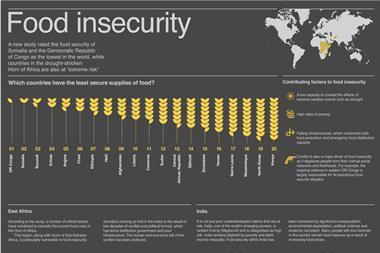What are the significant factors putting pressure on the world’s food and water supply and where are the risk hotspots
Changes in both human and natural systems are increasingly affecting water availability, access, quality and affordability.
The water management challenges facing individual countries are becoming more immediate and complex.
In addition to climate related events (e.g. flooding and drought) and increasing population pressures, the growing demand for biofuels in response to increasing oil prices has put further pressure on crop supplies.
Figures from the US Department of Agriculture show that at least one quarter of US grain crops are now converted into biofuels.
The World Food Progamme (WFP) has described the triple threat of climate change, population growth and rising food prices as having the potential to unleash a “perfect storm” of humanitarian crises.
Last year’s extreme weather events in Pakistan are expected to place additional pressure on supplies.
The WFP has expressed concerns that if prices continue to rise it will not be able to acquire the quantity of basic foodstuffs it needs to alleviate hunger in countries like Pakistan.
This will cause food security risk to increase further in Pakistan this year. Pakistan is currently ranked 28th and “high risk” in Maplecroft Food Security Risk Index.
Maplecroft’s Food Security Index (pictured) structure is based upon the FAO’s definition of food security as a state in which “all people, at all times, have physical, social and economic access to sufficient, safe and nutritious food to meet their dietary needs and food preferences for an active and healthy life.”
The index profiles the risk from lack of universal access to basic food staples in 163 countries.
Afghanistan (1) is rated as least secure in food supplies, whilst the African nations of the Democratic Republic of Congo (2), Burundi (3), Eritrea (4), Sudan (5), Ethiopia (6), Liberia (7), Angola (8), Chad (9) and Zimbabwe (10) are also considered “extreme risk.”
In all, African nations make up 36 of the 50 nations most at risk in the index.
Sub-Saharan Africa is particularly vulnerable to food insecurity because of the frequency of extreme weather events, high rates of poverty and failing infrastructure.
Conflict is also a major driver of food insecurity and the ongoing violence in Afghanistan and DR Congo is largely responsible for the precarious food security situation in both countries.
Read our analyst's 2011 food security forecast here.
Dr Anna Moss is a environmental analyst at Maplecroft.
.



















